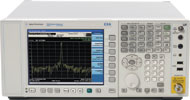

Agilent Technologies has introduced the new EXA signal analyser as a highly cost-effective millimetre-wave option, covering frequencies up to 44 GHz. With external mixing, it can cover up to 325 GHz. The result is easier, more accurate millimetre-wave measurements.
The need to test and operate systems in the millimetre-wave range continues today. Additionally, the growing demand for higher-resolution radar, imaging and sensor systems, along with multi-gigabit wireless and fibre data communications, has fostered increasing interest in high-frequency components and systems.
Like other Agilent X-Series signal analysers, the EXA is versatile, expandable, offers a broad set of measurement applications, and can be easily upgraded. In addition, its portability versus the PXA signal analyser (16 kg versus 22 kg) makes it ideal for millimetre-wave applications in aerospace/defence and wireless communications backhaul.
The EXA’s high sensitivity (< –140 dBm/Hz across the V-band with Agilent’s smart harmonic mixers) enables accurate measurement of spurs and harmonics. Along with its excellent phase-noise performance (-106 dBc/Hz typical at 10 kHz offset, 1 GHz carrier), the instrument is able to meet tight regulations and test requirements for millimetre-wave device design and performance verification.
Agilent also announced four new X-Series signal generators that provide elevated performance in phase noise, output power, ACPR, EVM and bandwidth. With these capabilities, the new MXG and EXG products (available in analog and vector models) support the development of components and receivers that meet the complex challenges of mitigating interference, speeding data throughput and increasing signal quality in applications such as radar, military communications and consumer wireless.

Today’s aerospace/defence environment requires enhanced radar performance to detect weak signals at long distances. To provide the pure and precise signals needed to test these designs, the MXG uses an innovative triple-loop synthesiser to deliver phase-noise performance of -146 dBc/Hz at 1 GHz and 20 kHz offset. For developers of radar components such as mixers and analog-to-digital converters, the device also features spurious performance of -96 dBc at 1 GHz.
In wireless communications, demand for more data and better coverage is driving higher performance in consumer devices and network infrastructure. For designers developing faster data streaming in 802.11ac devices, the MXG boasts factory-equalised 160 MHz RF bandwidth and ±0,2 dB flatness.
For those seeking to enhance range, mitigate interference and boost component performance, both the MXG and EXG deliver low EVM, output power up to +27 dBm, and ACPR of up to -73 dBc (W-CDMA test model 1, 64 DPCH).
To support a broad range of signals for cellular communications, wireless connectivity, video and navigation, the MXG and EXG provide real-time simulation of complex real-world signals. The associated Agilent Signal Studio software – a flexible suite of tools that accelerates signal creation – offers support for rapidly changing standards and highly complex signals such as real-time simulation of GPS or GLONASS constellations and performance testing of LTE base stations.
In manufacturing test, the cost-effective EXG is optimised for extended uptime and fast throughput (<900 μs switching). It also provides the signals needed for basic parametric testing of components and functional verification of receivers.
| Tel: | +27 12 678 9200 |
| Email: | [email protected] |
| www: | www.concilium.co.za/test-measurement |
| Articles: | More information and articles about Concilium Technologies |
© Technews Publishing (Pty) Ltd | All Rights Reserved